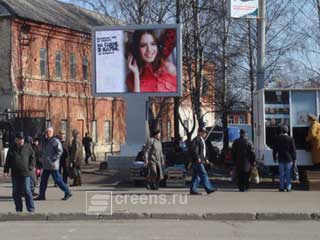Small cities LED billboards
If you read carefully magazines and on-line resources dedicated to LED billboards, digital advertising, new informational media, you will see hundreds of installations (large and mid-sized) in major cities in various countries. These cities appear in the news every day for different reasons: New York, Chicago, Johannesburg, Paris, and Moscow…
The business logic is transparent: it’s easier to sell in areas where population density is the highest so that your commercials affect the largest possible audience. There was a time when TV was the best media to reach potential buyers. Then the enemy of TV advertising was invented – remote control. TV channels started to multiply, ad-free commercial channels appeared, and the influence of TV advertising on people started to wane.
Advertisers started paying more attention to people in the streets, and large LED billboards (fearfully expensive at first) came very useful in brain-washing drivers bored by traffic jams and pedestrians waiting for their public transportation. LED billboards were first installed in the crowded squares, at busy crossroads, then on major highways. Ten years later the most attractive sites were exhausted, and LED structures started to get installed instead of traditional static billboards.
By now, large cities are already filled with LED billboards. For example, today there are more than 80 LED screens operated in Moscow, and more than 40 in the most unlikely city: St. Petersburg. This is not the limit, there will be more LED billboards, of course, but these numbers are fairly impressive considering the installation costs and some unforeseen expenses.
An installation of a new LED billboards in a big city is no longer news. However, a network of LED screens in a small city is a noticeable event. Few people outside of Russia would ever hear the names of the following cities: Dimitrovgrad, Murom and Serov, each boasting a population of about 100 thousand. However, even these small cities hurried to set up their own LED billboards networks. Consider another example: Vidnoje (Moscow Oblast) and Okha (Sakhalin Oblast) are not cities, they are settlements at best, but even these already own high-profile LED screen networks.
 |
 |
| LED screen in Murom | LED screen in Serov |
 |
 |
| LED screen in Vidnoje (Moscow Oblast) Photo credit: “S-Video” |
LED screen in Okha (Sakhalin Oblast) Photo credit: “Svetoform” |
Dmitry Melchuk, a representative of a small regional advertising agency, says: “Naturally, our audience is much smaller than that in the big cities. But advertisers are more interested in brand recognition and brand memorizing. From this point of view, the LED billboards in small cities are much more noticeable than in large cities”.
We would hardly think of writing about LED billboards in small Russian cities if we did not start getting news about similar tendencies in other countries, including the USA. For example, recently an outdoor advertising company in the small city of Ardmore in Oklahoma decided to set up advertising digital billboards though the population of this place is only around 25 thousand people. The network is not large – only three LED billboards, but the agency believes that more billboards will follow.
 |
 |
| LED digital billboards in the small city of Ardmore in Oklahoma Photo credit: www.dailydooh.com |
|
The LED digital billboards in such remote and lonely place instantly turned into a sensation. Local businesses realized that advertising on LED billboards raises their status in this small community where everyone knows about everyone. As a result in the first 45 days of LED billboards network operation the utilization of billboards (the index of advertising time sold) amounted to more than 90 percent. You may appreciate that number by comparing it with the average utilization index in Moscow LED digital billboards: in peak season it never exceeds 56%.
Thus, we are justified in saying that a new tendency is being born: the outdoor digital advertising is well-entrenched in large cities, and currently started an advance towards smaller provincial cities.





